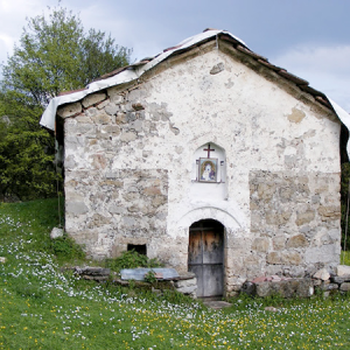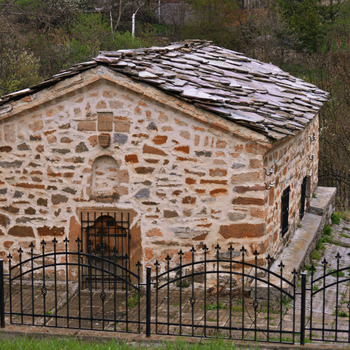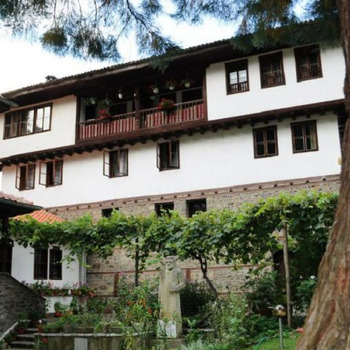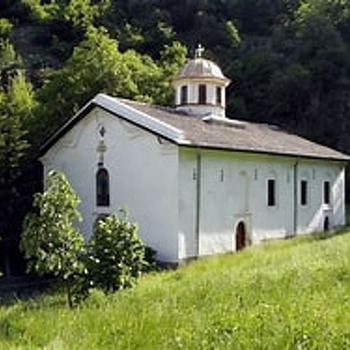Medieval Church of the Nativity of the Blessed Virgin Mary - Milanovo village
Overview
The medieval church of the Nativity of the Blessed Virgin Mary is located in the Staro Selo neighborhood, about 2 km east of the center of the village of Milanovo. Located in a picturesque area where the predecessor settlement of today's Milanovo was located. A good dirt road leads to the place, accessible for cars.
According to a commemorative inscription located on the west wall above the entrance from the inside, the church was built in 1492. The inscription was discovered by the writer Dimitar Nikolov, born in the village of Ozirovo, who copied it as it survived, translated it and published it in “Church Journal ”, no. 6 of 1940 in the article "An Old Sanctuary". Subsequently, the inscription suffered more damage to remain in the form we see today.
Information about the time of construction of the church can be found in the national memory. In the "Historical description of the village of Osikovo [the old name of Milanovo]" from 1927 it is said that "... the church was built when the houses had grown to 10-12". In the "History of the village of Milanovo" from 1973, referring to the data of Petar Gonkov Handzhiyski, mayor of the village around 1902, it is claimed that the church was built about 500 years ago. Later in the story it is stated that this happened due to the pressure of the Turkish enslaver. In the following centuries the temple was abandoned, but in 1865 it was restored and consecrated. Local legends say that the temple was built in the sunniest place, namely - in a place lit all day from sunrise to sunset.
Confirmation of the existence of an ancient temple, probably for consideration here, we find in the Ottoman tax documents: in the mufassal register (describes the soldiers living in the village) for the period 1515 - 1520 among the names of taxpayers are those of priest Radivoy and priest Radul; in the same inventory from 1541 - 1542 priest Bero and priest Peyo are mentioned, and in 1566 - 1574 - priest Doino. This is clear evidence that in those distant times of slavery in the village there was a Christian temple (probably not one, given the presence of many toponyms with Christian affiliation and consecration) and worship was performed - rays of light of the oppressed living in darkness. mountaineer.
According to a legend, in the yard in front of the church, which in our time is a meadow, was originally the cemetery of the village and later, also a long time ago, was moved to where the old cemetery is now. Graves and grave sites were arranged by surnames. On holidays such as St. George's Day, Petkovden and others. the people were arranged by families in the yard in front of the church, just as the cemetery was arranged by families. After a tragic catastrophe and the death of 15 people from the village of Milanovo in 1968, the cemetery from the Old Village was moved to the area "Church", where it is today, without following the traditional order and order by clans and families. Nowadays, a fair with a sacrifice, a church service and a holy water service for health is held at the old church in the Old Village.
The church in Staro Selo had a bell, which was purchased during the mayoralty of the mentioned Petar Gonkov Handzhiyski, i.e. around 1902. For this purpose the mayor collected copper from the people and at the expense of the collected quantity, a master made the bell. The old people who lived in Staro Selo know and remember what an incredible sound this bell had. The latter was stolen and then another was thrown along the road to the village of Druzhevo.
The church was not used for its purposes after the death of priest Simeon Kotsov Ragyov in 1984. It was repeatedly looted and desecrated. Fortunately, some of the surviving icons are still preserved today by the longtime church trustee Alexander Tsvetkov Aleksov from the village of Milanovo.
Architecturally, the church is one-nave and one-apse, with a semi-cylindrical stone vault. The canonical niche and washbasin are built into the northeast corner of her altar. The construction of the building is made of quarry stones welded with mortar. The roof is gabled, covered with stone slabs. Next to the west facade on both sides of the entrance there is a stone bench for the pilgrims to sit. Above the entrance there is a cartridge niche in which the image is covered by a much later plaster.
The whole church inside was painted with frescoes. Today, some fragments of them have been preserved, and not a small part of them have been preserved under later plasters. In the apse is relatively well preserved the image of the Mother of God Broad Heaven with a medallion on her chest of Christ - Emmanuel, and on both sides - two archangels. Below is a frieze with medallions of saints, and below them the church fathers, who are quite damaged and little is left of them. On the south wall there is a fragment of an image of a saint (behind the throne) and a biblical scene (next to the west wall). On the west wall, in addition to the memorial inscription, a badly damaged scene (to the left of the destroyed "Assumption") and the almost unrecognizable images of St. St. Constantine and Helena (north of the door) have survived. Only fragments of frescoes remain on the north wall, destroyed by moisture and mold over the years. At the zenith of the arch (in the western part) is a relatively well-preserved image of the Virgin. The best-preserved frescoes occupy a section of the vault (above the south wall) adjacent to the west wall. There is a wonderful performance of "The Last Supper".
The iconostasis is simple - wooden, relatively late made (the second half of the XIX century). The bishop's throne, attached to the south wall, also contributes to the interior design.
The church is an artistic cultural monument of national importance.


 Bulgarian
Bulgarian Romanian
Romanian



